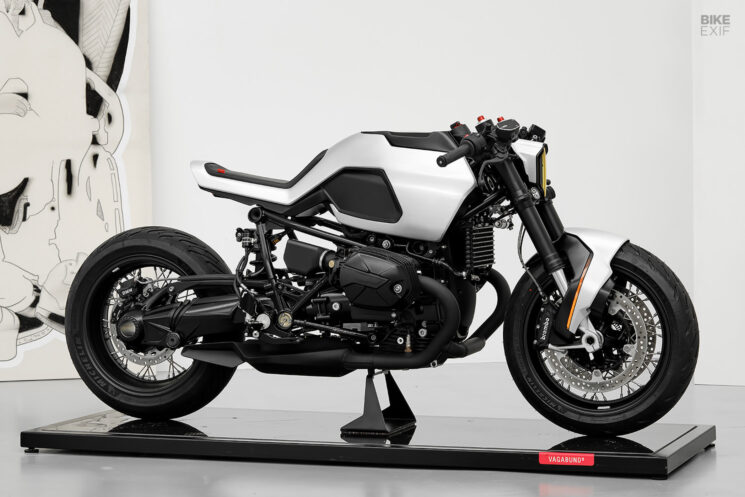
There are more ways to customize a motorcycle these days than ever before. You can take the traditional route and hammer your parts out of metal, or you can turn to modern manufacturing methods like 3D printing. Or you can play like Vagabund Moto—and throw every technique imaginable at one futuristic BMW R nineT custom.
Run by Paul Brauchart and Philipp Rabl, the Austrian shop has a reputation for pushing its limits on every custom build. They have a few BMW R nineT customs under their belt, each one just a little bit wilder than the last. And their latest cranks the radness up to eleven.
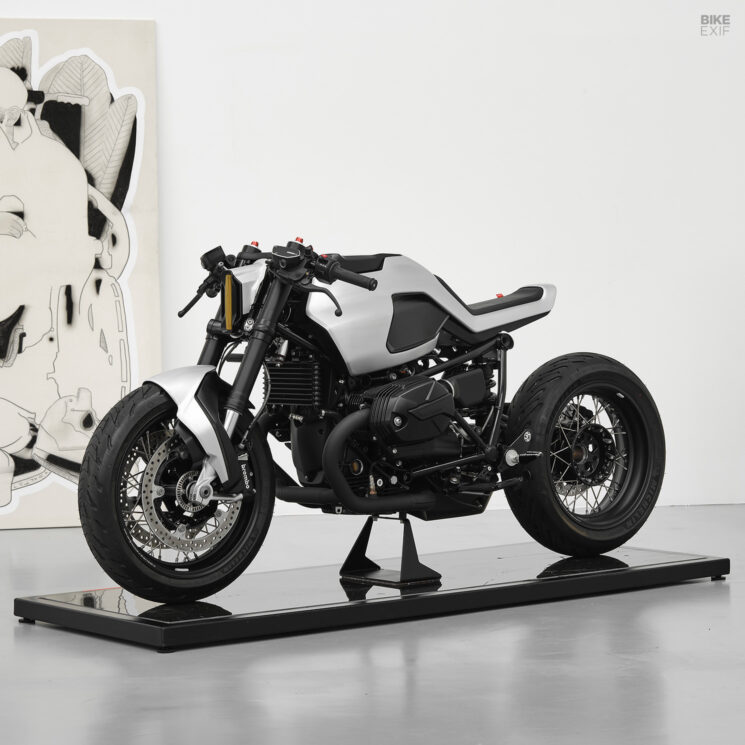
It’s the follow-up to a BMW R nineT that they built a couple of years ago. Designed with a monocoque body that lifted on hydraulic shocks, that bike landed in our annual editor’s choice top 10. This one’s in the same ballpark aesthetically, but sports several unique details.
Once again, Paul and Philipp roped in the enigmatic Bernard ‘Blechmann‘ Naumann to collaborate on the project. Blechmann is a metal-shaping wizard with a deft hand and a healthy imagination, so his job was to handle all the aluminum and stainless steel fabrication on the R nineT.

Blechmann’s metalwork and Vagabund’s 3D-printed parts work so well together, that it’s hard to tell them apart in some places. The sculpted one-piece body unit is aluminum, incorporating the fuel tank, tail section, and seat pan. Perforated leather adorns the seat, with a custom subframe supporting the structure from below.
Like the BMW R nineT build that preceded it, this one’s bodywork has a layered effect. Except that where the predecessor’s entire monocoque ‘opened,’ this one uses a simpler system. Simple—but no less complicated to build.
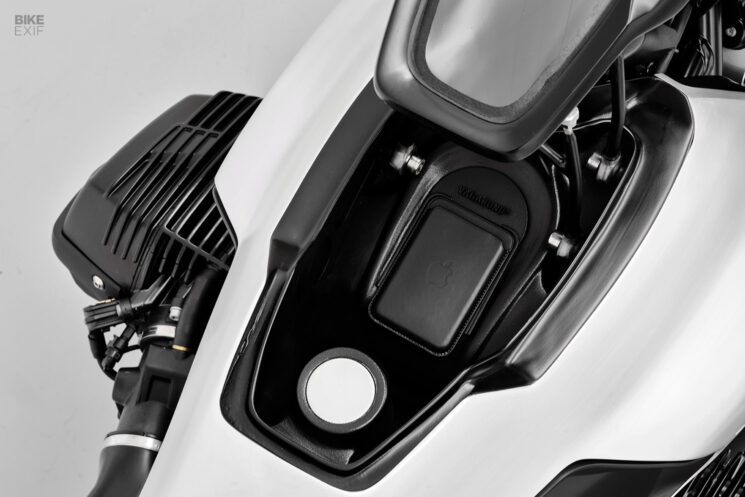
“All the bodywork was crazy stupid,” says Paul, exasperated. “We hadn’t planned to do an opening system again—but as stupid as we are, we did do it again.”
This time, it’s the bike’s custom-made dashboard that pops up. The unit features a black surround, with the OEM speedo mounted behind an acrylic panel. An aluminum hinge system with a hydraulic shock raises it, exposing storage for a magnetic card wallet, and the fuel filler.
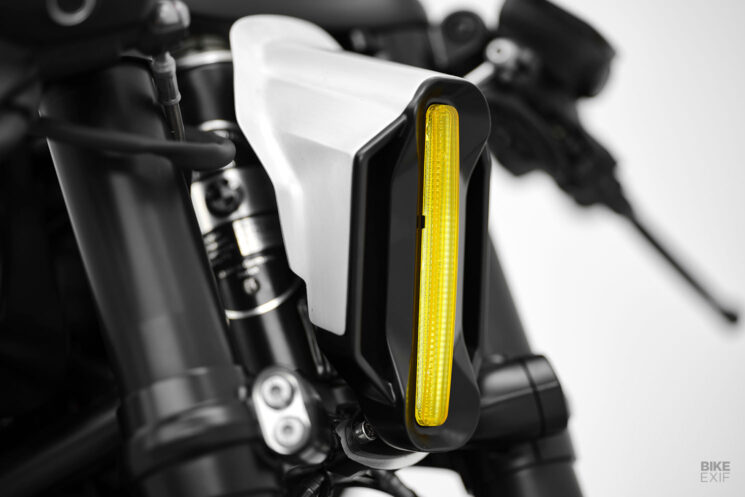
When the panel is down, the overall design is impressively cohesive. It also adds to the BMW’s overall sci-fi feel, as does the vertically-oriented LED headlight. Built using a combination of aluminum and 3D-printed parts, it has an almost robotic vibe to it.
Vagabund kept the OEM speedo because it removed at least some of the complications associated with customizing a modern motorcycle. That’s because this particular BMW R nineT is a 2022 model, so it has electronic frou-frou like traction control and switchable rider modes. Keeping the stock clock and switchgear removed the headache of having to find a way around all of that.
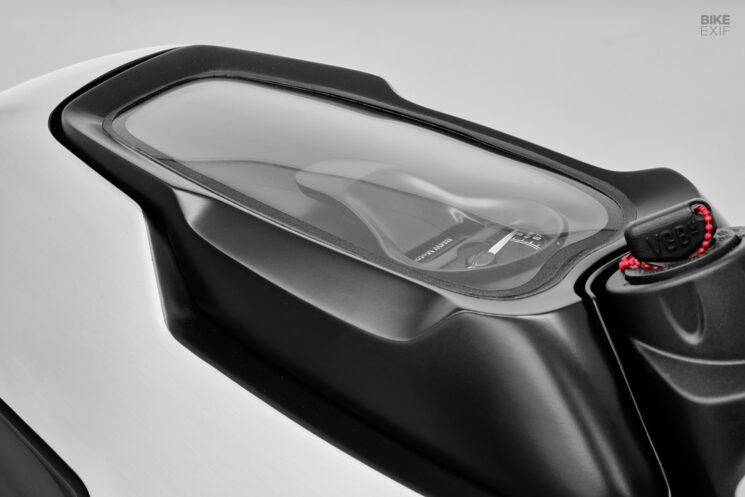
“It was particularly challenging to handle the bike’s electronics,” Paul confirms. “Since the bike was a 2022 model, it was even more complicated than our last build. Integrating and preserving all the stock parts and functionality that we thought was necessary; the electronic rider aids, fuel pump, and catalytic converter.”
“Form follows function. It’s easier to build something that isn’t road legal—or, worst case scenario, something that doesn’t really work.”

There’s more mechanical art up front, where Blechmann shaped a custom aluminum front fender, which also houses the front turn signals. Vagabund repurposed the LED strips that you’d normally find on automotive mirrors to create them.
An LED taillight sits at the opposite end of the bike, tucked under the tail. It’s wedged into a custom housing that places it vertically to mirror the headlight design. A bolt-on Rizoma license plate mount (not pictured) takes care of the rest.
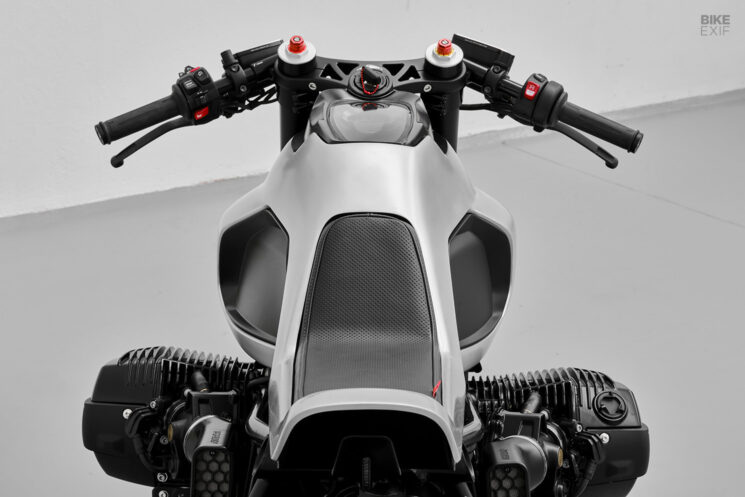
With the speedo now sitting on top of the tank, the R nineT’s cockpit is as sparse as they come. Vagabund installed a CNC-machined top yoke from Messner Moto, along with clip-ons, and brake and clutch fluid reservoir caps, from Rizoma. Rizoma also supplied the rear-set foot controls.
Subtle details abound, like the 3D-printed ignition surround and the indented panels that sit on either side of the fuel tank.
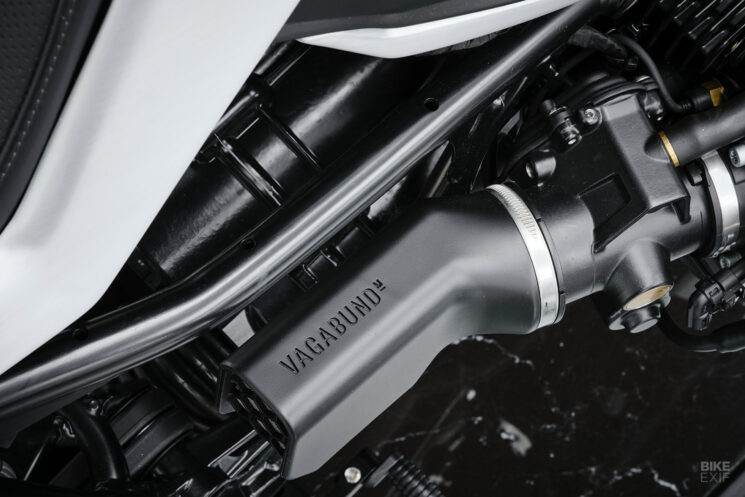
Paul and Philipp are obsessive about little touches like these. They could have used any number of aftermarket air filters on the boxer motor’s intakes—but they decided to 3D print their own filter housings instead.
The exhaust is a work of art too. Fabricated out of stainless steel, it’s a two-into-one system that exits low on the right-hand side, with a muffler design that can only be described as steel origami. The original catalytic convertor hides under the bike, and the exhaust’s noise levels are adjustable.

Vagabund’s signature look is minimal and clean designs, with strong industrial design and architectural influences. This BMW R nineT follows that style guide perfectly, right down to its paint job—or rather, lack thereof.
Opting to put Blechmann’s work on full display, Vagabund treated the bodywork to a brushed finish before sending it off to IFlow for a clear coat. The bike’s hard parts were done in black—including the fork legs, which Vagabund had anodized.

The BMW R nineT has been on the market long enough that that custom scene is slowly starting to become saturated with them. But that doesn’t faze Vagabund Moto—as always, their work has no trouble standing out.
Vagabund Moto | Facebook | Instagram | Blechmann | Instagram | Images by Stefan Leitner
